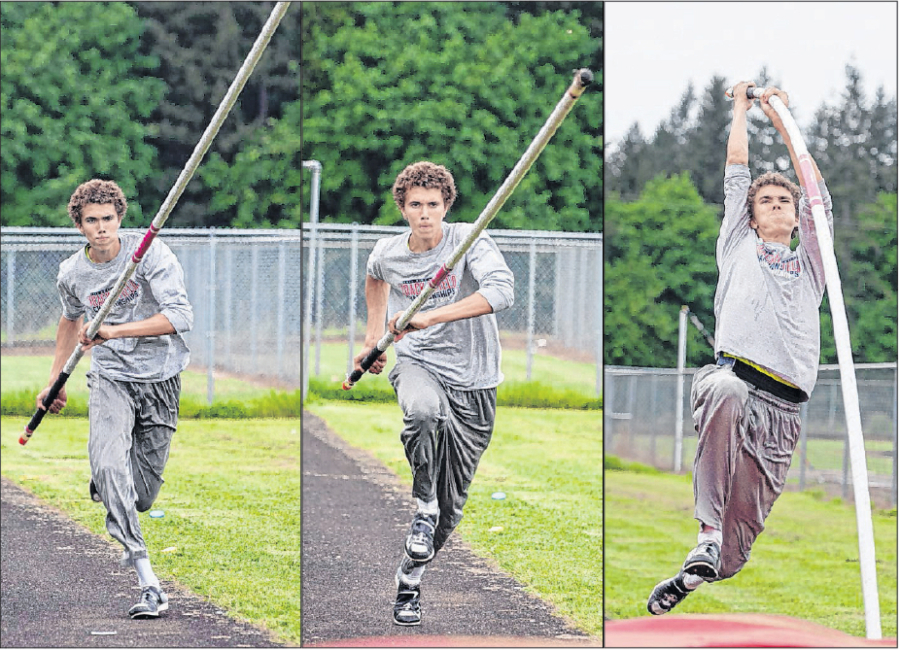It might be the busiest five seconds in sports.
From the first step to landing safely in a padded “pit,” there are more than a dozen things a pole vaulter must accomplish.
To get over the bar, none of them can go wrong.
Frank Schmidt understands that the pole vault can be intimidating. Over 16 years at four different high schools, the coach has helped dozens of Clark County athletes use a fiberglass pole to launch themselves over a bar 10 or more feet in the air.
His son, Michael, is one of the area’s best. The Prairie senior cleared 13 feet, 6 inches to place eighth at the Class 3A state meet last year.
Michael is following in the footsteps of two older brothers, Taylor and Josiah, who vaulted in high school. His younger sister, Valerie, is a Prairie sophomore who is learning to vault.
Frank Schmidt has a knack of making the most intimidating event in track and field accessible. But that doesn’t mean it’s for everyone.
“It’s the toughest technical event in track and field,” the Prairie assistant coach said. “It’s going to take someone who applies themselves, works on their mistakes and is willing to put their body in positions it has never been in before.”
Michael Schmidt was wary of pole vaulting before trying it as a seventh-grader. As a 10 year old, he saw one of Taylor’s poles shatter into five pieces during a vault.
Though his brother wasn’t injured, the image stuck with Michael.
“When you see someone break a pole, you’re like ‘I don’t know if I want to do that,'” he said.
Frank Schmidt said there is one key that helps athletes overcome their fears — pace.
“If they have reservations, I say ‘look, I’m going to go slow enough so that this is never scary,'” he said. “But I’m going to give you confidence to do something that you’re afraid of.”
That means vaulters will spend days practicing in the middle of a field, far away from the pole vault pit.
They’ll practice getting comfortable holding the pole.
They’ll practice sprinting with the pole in their hands.
Finally, they’ll practice bringing the pole down so its end touches the right spot over and over again.
Once his athletes are ready to vault, Schmidt again focuses on that key word — pace.
But this time, pace refers to going fast. Going fast down the runway is the key to vaulting safely, Schmidt said.
Most pole vault injuries happen when the athlete falls into the “box,” the area at the front of the pads where the pole is planted.
Schmidt teaches his vaulters to run fast enough so their momentum will carry them well onto the padding, no matter what happens during the vault.
Though a vaulter’s run-up to pit might be 50 feet or more, it’s the final three steps that are the most important.
In that time, the vaulter must plant the pole’s end into the box. As the pole flexes, a vaulter thrusts their end of the pole upward with their arms as they leap off the ground.
Then, to hear Michael Schmidt describe it, you hang there for a split second as you feel the pole pull you even farther up.
Once he feels the pole’s pull, Michael focuses on pulling his hips past the pole’s end. At the same time, he rotates his body as he clears the bar.
By the time he’s past the bar, he’s facing back toward where he started.
Needless to say, it takes an extraordinary attention to detail to become a good vaulter. It’s something Frank Schmidt saw in himself as a track athlete at the University of Pennsylvania in the early 1980s.
As a decathlete, he was fascinated with the physics of the pole vault, hurdles and throwing events. He remembers doing hundreds of repetitions in a day, until he had a move just right.
He sees that same persistence in the 12 to 20 vaulters he typically coaches each year.
“There’s a certain personality that comes along with it,” he said. “I can see it develop as I’m coaching. They want to get something right. They’re very persistent.”
Pole position
Southwest Washington is home to some of the state’s best high school pole vaulters.
Trent Beavers, Kelso: His personal best of 14 feet, 11 inches is the third best in Class 3A this season. Finished third at the state meet last season.
Caleigh Lofstead, Camas: The Vanderbilt-bound senior is the defending 4A state champion, having cleared 12-7 at last year’s state meet. This year, she has cleared 13-3, the second-highest mark by any girl in the state.
Michael Schmidt, Prairie: The senior placed eighth in state last season, clearing 13-6 at the Class 3A state meet.
Laura Shannon, Battle Ground: The senior is one of eight girls in Class 4A to have cleared 11 feet this season.
Abby Weiler, R.A. Long: Last year’s Class 2A runner up has cleared 13-6, the best mark in the state this season. She will vault at the University of Washington.
Joey Weiler, R.A. Long: The defending 2A champion is one of three boys in the state to have cleared 16 feet this season. He is Abby’s twin brother.




